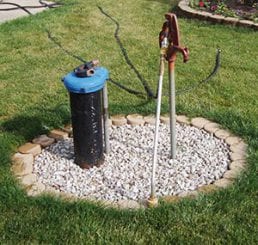Tribal Drinking Water Program Improvement
In 2017 and 2018, CDC, the Public Health Foundation (PHF), the Indian Health Service (IHS), and the National Environmental Health Association (NEHA) worked to build tribal capacity to ensure the safety of unregulated drinking water.
In 2017, the partners created and conducted a training for 24 participants from 13 tribes. CDC and PHF worked in-depth with three tribes to apply the training concepts and implement improvement projects. Training participants developed performance improvement competencies to support continual efforts for reassessing and improving drinking water program performance. Tribes that received the in-depth assistance with implementing improvement projects addressed priority needs and started ongoing processes for strengthening their programs.

Safe Water Is Critical to Protect Human Health
Similar to the overall U.S. population, tribes receive their drinking water through both regulated public water systems and unregulated water sources. The most common unregulated water source is private wells. Other unregulated sources include rainwater harvesting, springs, hauling and delivering by truck, river and lakes, and livestock watering points. Many of these unregulated sources are unidentified, and they may not have been tested for safe drinking water parameters.
Tribal communities face a variety of water supply related issues. They must combat difficulties due to
- Small populations.
- Remote or challenging geographic areas.
- A lack of records and monitoring data for existing water and contamination sources.
Other struggles include developing and maintaining technical, financial, and managerial capacity for drinking water programs.
What Did the Partners Do to Help Tribes?
Trained Tribes
The training focused on the 10 Essential Environmental Public Health Services and how that framework can be used to improve delivery of safe unregulated drinking water. Training participants used what they learned to begin to address longstanding challenges of ensuring safe drinking water for tribal communities.
Helped Tribes Apply Training Concepts
Following the training, in 2017 and 2018, CDC and PHF helped the Cherokee Nation, OK, Northern Cheyenne Tribe, WY, and Tuscarora Nation, NY implement the concepts they learned and provide hands-on help to
- Establish water program improvement plans.
- Inventory and describe available environmental and health data sources.
- Manage data to prioritize water program improvement needs.
CDC and PHF helped the tribes review performance assessment results for their drinking water programs using the Environmental Public Health Performance Standards. They also helped each tribes identify a program improvement priority addressing one or more of the 10 Essential Environmental Public Health Services. The team then assisted in the design and implementation of a performance improvement project to address the identified priority.
Cherokee Nation
- Completed water testing outreach and education.
- Developed a sanitary survey form for a more comprehensive well assessment approach.
Northern Cheyenne Tribe
- Drafted and completed a Memorandum of Agreement and resolution to establish a private drinking water program with multiple program partners. The Tribal Council passed the resolution in September 2017.
Tuscarora Nation
- Assessed improvements needed in tribal member education regarding drinking water well safety and septic systems.
- Piloted an incentive-based training program that increased tribal member participation five-fold.
Cherokee Nation
- Built relationships between environmental health, public health, and the environmental program; completed a comprehensive inventory of available drinking water and health data sources; conducted a gap analysis; and explored opportunities to integrate data sources.
- Established a collaborative to review sources for human health data and IHS’s Sanitation Tracking and Reporting System (STARS) to potentially screen households for health issues and determine referral programs to solve community environmental health problems.
As a further collaboration between clinical health and environmental health, the Cherokee Nation also developed plans to
- Establish a consistent lead clinical testing protocol and formalized the referral process of members with elevated blood lead levels between clinicians and the environmental health program.
- Initiate a pilot project to complete a weekly screening form focused on environmental health and drinking water at a clinic in a rural area with a high concentration of residents using private wells.
Northern Cheyenne Tribe
- Developed a data management system for hundreds of drinking water well records provided by IHS. This information will be used to establish plans and projects for the drinking water program.
Tuscarora Nation
- Obtained a database server and an intern created a database housing the results of past drinking water well surveys and sample results provided by IHS and other agencies.
- Ensured uniformity of forms and data entry protocols for future data entry and sample analysis. The database will be used to inform safe drinking water program decisions.
Want More Information?
Read the PHF blogexternal icon about this work.
Learn more about the Environmental Public Health Performance Standards and the 10 Essential Environmental Public Health Services.
Take the Safe Water Performance Improvement training.
Find more Background on Private Drinking Water and Public Health
